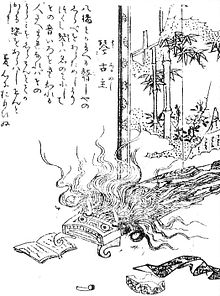Koto-furunushi

The Koto-furunushi ( Japanese. 琴 古 主 ; to German "old master Koto ") is a fictional being of the Japanese folk belief . He is a yōkai , is considered harmless and is very similar to the being Biwa-bokuboku .
description
The Koto-furunushi has the shape of a traditional Koto , which grows a grimaceous face on its front end. The strings come loose and now stand out wildly in all directions like a long mane . However, it is not known whether the Koto-furunushi can walk or otherwise move.
folklore
A well-known, old legend from the Saga Prefecture on the island of Kyushu is said to date from the 2nd century AD. She tells of a sumptuous banquet at the imperial court. In order to be able to hold the festival in a fitting location, the Japanese ruler had an overgrown garden near Kanzaki trimmed and cleared. The emperor is said to have been so enthusiastic about the result that he left the court with an enchanted koto, which soon afterwards turned into a huge, lush camphor tree . For centuries since then, it has been said that anyone who lingers near the tree on particularly quiet and peaceful nights can hear lovely harp tones . Although the location of the sacred camphor tree has been forgotten over time, the spirit that is supposed to reside in the tree occasionally drives into hundred-year-old kotos and brings them to life.
background
The being Koto-furunushi belongs to a special group of yōkai, the tsukumogami ( 付 喪 神 , dt. "Artefact spirits"): According to Japanese popular belief, household appliances and musical instruments of all kinds can turn into yōkai after 100 years, because too they have a soul. Koto-furunushi also develop a life of their own when they make their “100. Birthday ”. If they continue to be treated with great respect after their transformation, on quiet days they will automatically play pieces of music that have been performed on them over the years and which are therefore remembered. If, on the other hand, koto-furunushi is ignored, they ask other tsukumogami to take them with them so that they can play something for the tsukumogami whenever the opportunity arises.
literature
- Hiroko Yoda, Matt Alt: Yokai Attack !: The Japanese Monster Survival Guide . Tuttle Publishing, Rutland 2013, ISBN 1462908837 .
- Hisashi Yamauchi: も の の け . Hōsei daigaku shuppan-kyoku, Tokyo 2004, ISBN 4588212222 .
- Shigeru Mizuki: 水木 し げ る の 妖怪 百 物語: 日本 篇 . Futami Shobō, Tokyo 1999, ISBN 978-4-576-99102-3 .
- Michaela Haustein: Mythologies of the World: Japan, Ainu, Korea . ePubli, Berlin 2011, ISBN 3844214070 .
Web links
- Description of the Koto-furunushi on Yokai.com . (English)